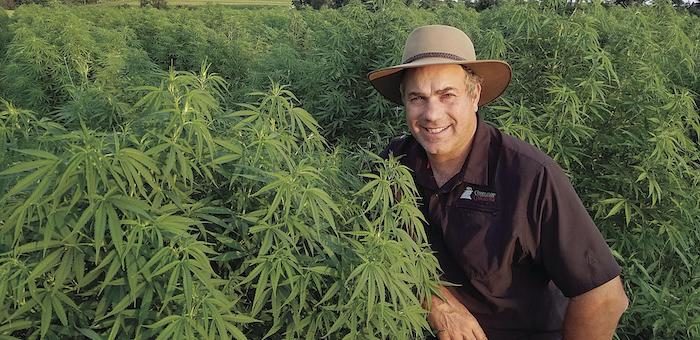
Hear from Cover Crop Coach Steve Groff during a live session during the National Cover Crop Summit March 14-16, 2023. Groff is part of another can't-miss lineup of today's most successful cover cropper adopters, researchers and agronomists sharing their best seeding strategies, grazing and feeding tips, variety selection secrets and more. Click the button below to register!
Here in Pennsylvania, we now have four growing seasons under our belts since hemp become legal to grow in 2019.
It started off euphoric as the CBD sector was hot — but then just as fast, it was not. What does hindsight reveal? We now know that only a tiny number of acres were grown for CBD prior to 2019, and it was not enough to meet demand of the retail product at the time, creating sky-high prices.
Suddenly, thousands of acres were planted, and farmers found it to be a relatively easy crop to grow. Yields were very good. But the infrastructure to handle the volume was not yet built. It was like inventing cars before the roads were built. As 2022 winds down, I am one of only a remaining handful of CBD producers in the state.
The common thread among those of us still growing is that we established our own brands. It has not been an easy path, but I believe in the future of all aspects of hemp, and I intend to do my part in advancing this industry. 2033 is a long way off, but I’m convinced that the hemp industry will have matured with infrastructure and new markets being developed by then.
The Headwinds. There are still significant challenges in front of us. Much of the banking sector is still not open to dealing with anything related to hemp. Our hemp business banking was shut down four times due to us not complying with the “Schedule I Controlled Substance under the Controlled Substances Act,” although everything we are doing is legal.
Fortunately, there are a few banks that now accommodate hemp, but getting any loans for building infrastructure is nigh unto impossible which limits those projects to private funding sources.
The marijuana myths are taking a while to overcome. For instance, hemp grown for fiber and textiles has only a tiny fraction of THC, the psychoactive compound in marijuana, but we still are required to have the state test before harvest. It’s not that the $80 test breaks the bank, but it feels like we are being treated like criminals for a plant whose architectural structure does not resemble a pot plant.
It was understood that the FDA was going to come out with guidelines for the retail sales of CBD products within a reasonable amount of time after the 2018 Farm Bill legalized the growing of hemp. Here we are four years later with no guidelines in sight. This has led to the major retailers shying away from selling ingestible CBD products — dramatically limiting market potential.
The main reason given for the delay is “we need more research.” I totally support that, but for a plant that has been around and ingested for thousands of years, it seems like we could have been further along by now.
The Opportunities. Despite the headwinds, opportunities abound. I believe the grain sector will escalate quickly once legalized for animal use. Currently, this use has not been approved, although you can go to your local natural food store and buy all the hemp seeds you want for human consumption.
Here locally, Kreider Farms has led the way with their exception they got approved for feeding chickens hemp grain that results in healthier eggs.
In addition, the Hemp Feed Coalition is actively lobbying legislators to allow for hemp grain to be used in animal feed rations. This will lead to opening significant more uses. Hemp for grain is not hard to grow, and the equipment needed to harvest and process can be retrofitted from existing machinery.
Fiber and textiles show tremendous promise and are indeed now getting viable traction. I grew 5 acres of this type of hemp in 2022.
Hemp also has a strong appeal within the regenerative agriculture movement. The crop I grew this past year was no-till planted into a green cover crop. Weed control and fertility were excellent, utilizing roughly half the inputs compared to using conventional methods.
CBD is situating itself firmly in the emerging “plant-based medicine” market and I expect that to continue to expand.
My vision for the next decade is that farmers will be growing hemp as a viable cash crop. People will benefit by consuming and using the dozens of products derived from this plant — a gift that keeps on giving. And using regenerative agriculture practices will enhance the environment.
Will we ever see hemp grown on every farm like it was over a hundred years ago? Probably not, but I firmly believe it will become a common sight over the next decade benefiting both people and the planet.







